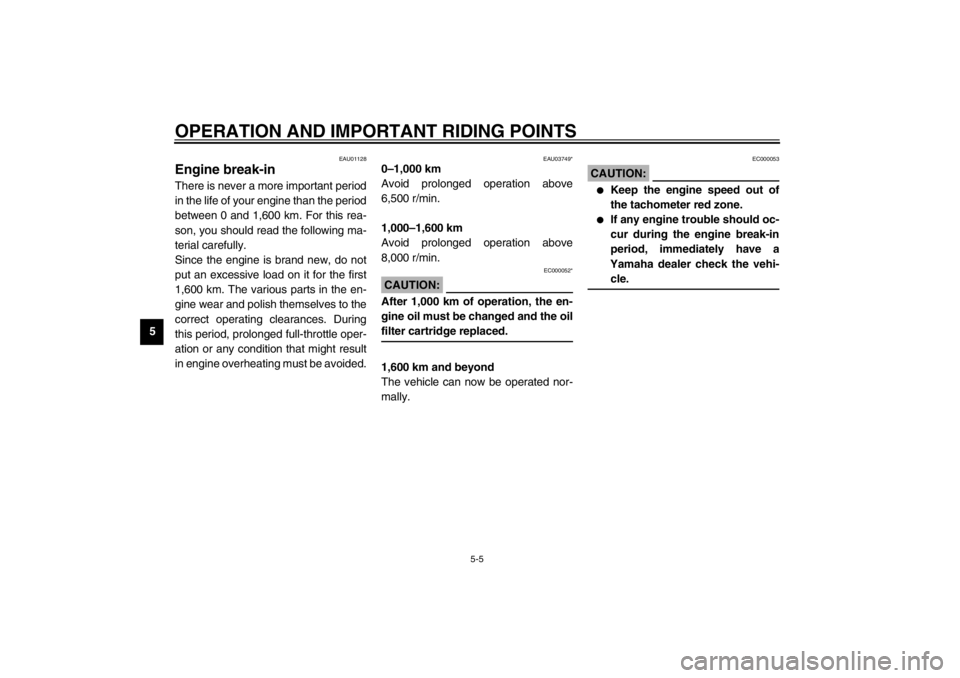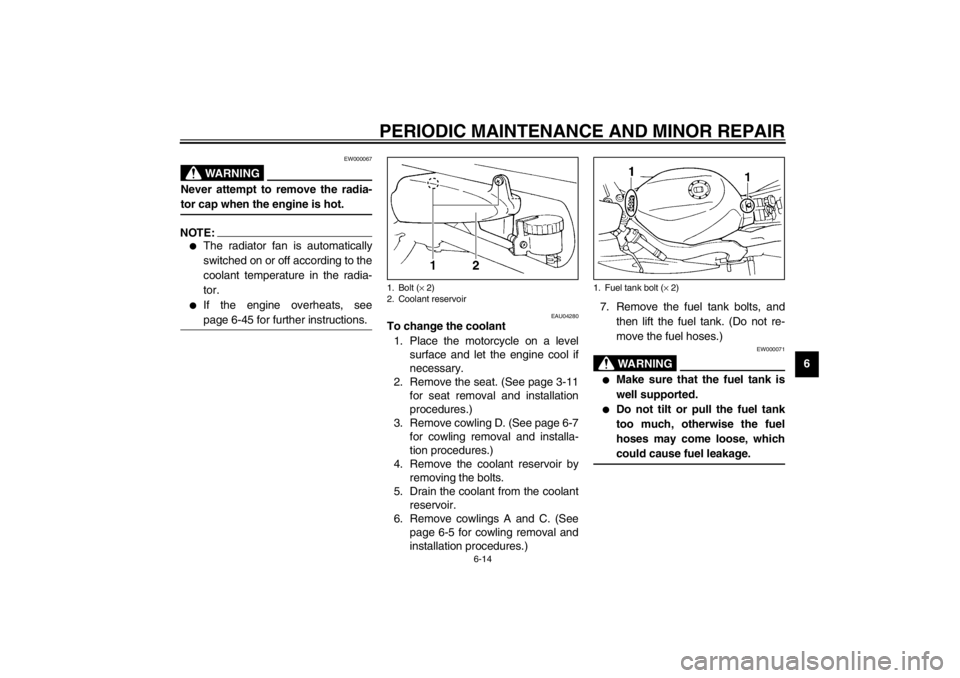Page 20 of 114

INSTRUMENT AND CONTROL FUNCTIONS
3-5
3
EAU01652
Coolant temperature gauge With the key in the “ON” position, the
coolant temperature gauge indicates
the temperature of the coolant. The
coolant temperature varies with chang-
es in the weather and engine load. If
the needle reaches or enters the red
zone, stop the motorcycle and let the
engine cool. (See page 6-45 for further
instructions.)
EC000002
CAUTION:_ Do not operate the engine if it is
overheated. _
EAU00109
Anti-theft alarm (optional) This motorcycle can be equipped with
an optional anti-theft alarm by a
Yamaha dealer. Contact a Yamaha
dealer for more information.
EAU00118
Handlebar switches
EAU00120
Pass switch “PASS”
Press this switch to flash the headlight.
EAU03888
Dimmer switch “/”
Set this switch to “” for the high
beam and to “” for the low beam.
1. Coolant temperature gauge
2. Coolant temperature gauge red zone
1. Pass switch “PASS”
2. Dimmer switch “/”
3. Turn signal switch “/”
4. Horn switch “”
U4TVE6.book Page 5 Saturday, August 4, 2001 12:14 PM
Page 46 of 114

OPERATION AND IMPORTANT RIDING POINTS
5-5
5
EAU01128
Engine break-in There is never a more important period
in the life of your engine than the period
between 0 and 1,600 km. For this rea-
son, you should read the following ma-
terial carefully.
Since the engine is brand new, do not
put an excessive load on it for the first
1,600 km. The various parts in the en-
gine wear and polish themselves to the
correct operating clearances. During
this period, prolonged full-throttle oper-
ation or any condition that might result
in engine overheating must be avoided.
EAU03749*
0–1,000 km
Avoid prolonged operation above
6,500 r/min.
1,000–1,600 km
Avoid prolonged operation above
8,000 r/min.
EC000052*
CAUTION:_ After 1,000 km of operation, the en-
gine oil must be changed and the oil
filter cartridge replaced. _1,600 km and beyond
The vehicle can now be operated nor-
mally.
EC000053
CAUTION:_ �
Keep the engine speed out of
the tachometer red zone.
�
If any engine trouble should oc-
cur during the engine break-in
period, immediately have a
Yamaha dealer check the vehi-
cle.
_
U4TVE6.book Page 5 Saturday, August 4, 2001 12:14 PM
Page 63 of 114

PERIODIC MAINTENANCE AND MINOR REPAIR
6-14
6
EW000067
WARNING
_ Never attempt to remove the radia-
tor cap when the engine is hot. _NOTE:_ �
The radiator fan is automatically
switched on or off according to the
coolant temperature in the radia-
tor.
�
If the engine overheats, see
page 6-45 for further instructions.
_
EAU04280
To change the coolant
1. Place the motorcycle on a level
surface and let the engine cool if
necessary.
2. Remove the seat. (See page 3-11
for seat removal and installation
procedures.)
3. Remove cowling D. (See page 6-7
for cowling removal and installa-
tion procedures.)
4. Remove the coolant reservoir by
removing the bolts.
5. Drain the coolant from the coolant
reservoir.
6. Remove cowlings A and C. (See
page 6-5 for cowling removal and
installation procedures.)7. Remove the fuel tank bolts, and
then lift the fuel tank. (Do not re-
move the fuel hoses.)
EW000071
WARNING
_ �
Make sure that the fuel tank is
well supported.
�
Do not tilt or pull the fuel tank
too much, otherwise the fuel
hoses may come loose, which
could cause fuel leakage.
_
1. Bolt (× 2)
2. Coolant reservoir
1. Fuel tank bolt (× 2)
U4TVE6.book Page 14 Saturday, August 4, 2001 12:14 PM
Page 94 of 114

PERIODIC MAINTENANCE AND MINOR REPAIR
6-45
6Engine overheating
EW000070
WARNING
_ �
Do not remove the radiator cap when the engine and radiator are hot. Scalding hot fluid and steam may be
blown out under pressure, which could cause serious injury. Be sure to wait until the engine has cooled.
�
After removing the radiator cap retaining bolt, place a thick rag, like a towel, over the radiator cap, and then
slowly rotate the cap counterclockwise to the detent to allow any residual pressure to escape. When the hiss-
ing sound has stopped, press down on the cap while turning it counterclockwise, and then remove the cap.
_NOTE:_ If coolant is not available, tap water can be temporarily used instead, provided that it is changed to the recommended coolant
as soon as possible. _
Wait until the
engine has cooled.
Check the coolant level in the
reservoir and radiator.
The coolant level
is OK.The coolant level is low.
Check the cooling system
for leakage.
Have a Yamaha dealer checkand repair the cooling system.Add coolant. (See NOTE.)
Start the engine. If the engine overheats again,
have a
Yamaha dealer check
and repair the cooling system.
There is
leakage.
There is
no leakage.
U4TVE6.book Page 45 Saturday, August 4, 2001 12:14 PM